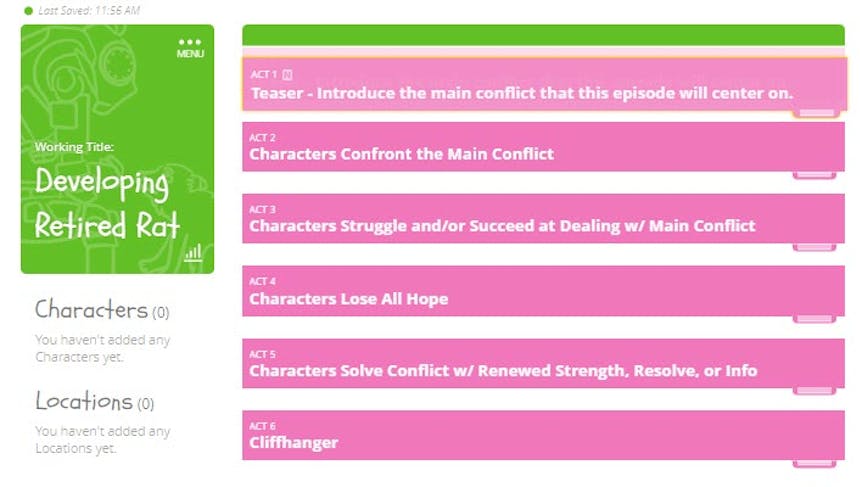With one click
Export a perfectly formatted traditional script.
We're smack dab in the golden age of television, and thanks to the many streaming offerings and new ways we consume media, it shows no signs of stopping. As a screenwriter, it's become more common to write for both features and television. Maybe you've never written a TV script before? Where do you even start? This blog is for you! I'm covering the basics of how to write and structure a TV show script.
Export a perfectly formatted traditional script.


Are you writing an original television pilot? The pilot is the first episode, the introduction to the world of a television show. The idea is that it will set up the story and characters and hook audiences into wanting to see more.
Are you writing a spec script? In television, a spec script is a sample episode written for a currently airing TV show. A spec script aims to show that the writer can assume the show's voice and tone and maybe land a gig in the writers' room. While not as common as they once were, sometimes spec scripts are still required for writing jobs. Most commonly, I see spec scripts required for writing competitions or fellowship opportunities. For this blog's purpose, I'm not going to focus on writing a spec script, but I felt it was important for you to know what they are!
30-minute and 1-hour are the standard lengths of time for television shows. However, things are changing as we watch more and more content via streaming. Comedies used to be the only type of 30-minute content out there, but now we see a rise in 30-minute dramas and dramedies like "Atlanta," "Barry," and "Russian Doll." Don't let the genre dictate the length of your script. When trying to figure out how long your script should be, consider which amount of time will best serve your story. In many situations, we no longer have to work around commercial breaks, so the length of every episode in your show can vary slightly.
In a feature, you start and finish a story in 90-120 minutes. With a pilot script, you have around 60 minutes at most, and it needs to hook a reader, making them want more from your story in future episodes. It would be best to tease potential directions the show will go in without giving too much away in each episode. A television show requires you to build a rich, big world with vibrant characters who will provide stories for (ideally) multiple seasons.
When you understand the scope of a television show, you understand the kind of planning required to craft one. Doing a lot of pre-writing and outlining the series and characters will help you have a strong handle on the show's world.
When it comes to structuring a feature, writers use all sorts of different act structures. When it comes to writing a 1-hour television show, the structure is a bit more standardized. 1-hour shows start with a teaser section and are commonly followed by 4 or 5 acts. A teaser is a short opening, usually set in one location, that runs a couple of minutes (between 2-3 pages). The teaser is meant to tease some sort of conflict that viewers will learn more about in the episode. The script should total around 45-75 pages.
To set up this 1-Hour TV Script Structure in SoCreate, first head to your dashboard and select “I want to create a new TV show” from the top project options.
Next, choose a working title for your TV show episode, or use SoCreate’s random name generator by simply clicking “create story.”
Now that you’ve created a TV show project, I’d recommend building out the structure so you have an outline to work from for your 1-hour episode.
Start by adding 5-6 acts from the Tools Toolbar to the right-hand side of your screen. Click “Add Story Structure,” then choose “Add Act.”
Name the first act “Teaser.”
Next, add 3-5 scenes within each act, by clicking “Add Story Structure” from the Tools Toolbar, then “Add Scene.” You can always add or remove scenes later once you determine how many scenes you’ll need to tell your story.
Below, see what a 1-hour TV show outline might look like by acts.

Of course, you can always rename your acts and scenes to better match what’s happening in your script.
Things can be a little more fast and loose when it comes to structuring a 30-minute show. As I said before, we see a lot of reinvention in 30-minute shows these days, so when writing one, my best advice is to think of it in terms of the beginning, middle, and end – or three acts plus a teaser (also called a cold open in a sitcom), and sometimes a tagout (one final laugh or cliffhanger) - all while keeping in mind how it will serve an entire season. A typical 30-minute TV show script will be around 22-38 pages, depending on the genre.
To set up this 30-Minute TV Script Structure in SoCreate, first head to your dashboard and select “I want to create a new TV show” from the top project options.
Next, choose a working title for your TV show episode, or use SoCreate’s random name generator by simply clicking “create story.”
Start by adding 4 acts from the Tools Toolbar to the right-hand side of your screen. Click “Add Story Structure,” then choose “Add Act.”
Name the first act “Teaser" or "Cold Open."
Next, add 3-5 scenes within each act, by clicking “Add Story Structure” from the Tools Toolbar, then “Add Scene.” You can always add or remove scenes later once you determine how many scenes you’ll need to tell your story.
Below, see what a 30-minute TV show outline might look like by acts.

To pitch your TV show to executives, you need to know your show inside and out. You have to understand what kind of show your script is and where you can see it living. You can't expect an explicit show to air on a major network like NBC; that's not the right home for it. Meanwhile, it's going to be harder to sell a sitcom to Netflix or Amazon.
Supplemental materials like a show bible and a pitch deck can help you more clearly explain and demonstrate your show's world. Writing a series outline along with brief episode summaries for the first season will not only show to others that your show has legs but will help you to solidify your understanding of the show.
Phew, it was hard for me to narrow down the most important things about writing a TV show into this one blog! Hopefully, this gave you a firm overview of what it's like to write a television pilot. Writing a TV show is unlike anything else because it truly allows you to build a huge world, all with the goal of allowing other people to join you in making that world come to life! Good luck with your pilot script, happy writing!